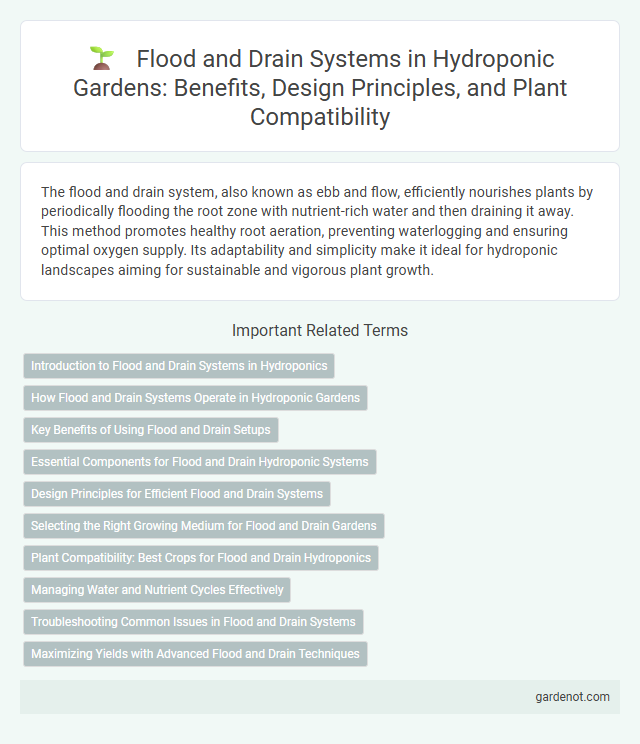The flood and drain system, also known as ebb and flow, efficiently nourishes plants by periodically flooding the root zone with nutrient-rich water and then draining it away. This method promotes healthy root aeration, preventing waterlogging and ensuring optimal oxygen supply. Its adaptability and simplicity make it ideal for hydroponic landscapes aiming for sustainable and vigorous plant growth.
Introduction to Flood and Drain Systems in Hydroponics
Flood and drain systems, also known as ebb and flow systems, are a popular hydroponic method that periodically floods the grow tray with nutrient-rich water before draining it back into a reservoir. This cyclical process ensures optimal oxygenation of plant roots while delivering essential nutrients for growth. Key components include a water pump, grow tray, reservoir, and timed flooding cycles, making this system highly efficient for a variety of crops.
How Flood and Drain Systems Operate in Hydroponic Gardens
Flood and drain systems in hydroponic gardens operate by periodically flooding the plant roots with nutrient-rich water, then draining it to allow air circulation and prevent waterlogging. A timer controls the flood cycles, ensuring optimal hydration and oxygenation to promote healthy root growth. This ebb and flow mechanism enhances nutrient uptake and supports vigorous plant development in hydroponic landscapes.
Key Benefits of Using Flood and Drain Setups
Flood and drain systems in hydroponic landscapes provide efficient water and nutrient delivery by periodically flooding the root zone and then draining it, which promotes oxygenation and prevents waterlogging. This method enhances plant growth rates and reduces disease risks due to better root aeration and consistent moisture levels. Flood and drain setups also allow for precise control over nutrient uptake, increasing yields and conserving water resources.
Essential Components for Flood and Drain Hydroponic Systems
Flood and drain hydroponic systems rely on essential components such as a water reservoir, a submersible pump, growing trays, and a timer to regulate flooding cycles. Growing trays hold the plants and nutrient solution, while the pump ensures timely irrigation by flooding the trays and then draining back into the reservoir for oxygenation. The timer automates the flooding intervals to maintain optimal nutrient delivery and prevent root waterlogging, maximizing plant growth efficiency.
Design Principles for Efficient Flood and Drain Systems
Flood and drain systems in hydroponic landscapes rely on precise design principles such as optimal tray depth, consistent flooding cycles, and efficient drainage slopes to enhance nutrient absorption and root oxygenation. Maintaining a balance between flood duration and drainage time prevents root suffocation and promotes healthy plant growth. Incorporating durable materials and adjustable flood timers ensures system reliability and adaptability to various crop requirements.
Selecting the Right Growing Medium for Flood and Drain Gardens
Choosing the right growing medium for flood and drain hydroponic systems is crucial for optimal plant growth, water retention, and root aeration. Common media like expanded clay pellets, perlite, and coconut coir offer excellent drainage and moisture balance, preventing root rot and ensuring efficient nutrient uptake. The ideal medium should provide sufficient support while maintaining porosity to facilitate the cyclical flooding and draining process characteristic of flood and drain gardens.
Plant Compatibility: Best Crops for Flood and Drain Hydroponics
The flood and drain system excels with crops that thrive in intermittent water and oxygen supply, such as leafy greens like lettuce, spinach, and kale, as well as herbs including basil, mint, and cilantro. Fruit-bearing plants like strawberries and tomatoes also perform well due to the consistent nutrient cycling and aeration this system provides. Root crops and delicate plants are less compatible, making flood and drain ideal for fast-growing, water-tolerant species.
Managing Water and Nutrient Cycles Effectively
The Flood and drain system in hydroponic landscapes efficiently cycles water and nutrients by periodically flooding the plant roots and then draining the solution, ensuring optimal oxygen availability and nutrient absorption. This method reduces water waste and prevents nutrient runoff by recirculating the nutrient solution in a closed loop. Effective management of water levels and timing controls promotes healthy root development and maximizes plant growth in hydroponic setups.
Troubleshooting Common Issues in Flood and Drain Systems
Flood and drain hydroponic systems often face issues such as root rot caused by overwatering, clogged drain pipes that disrupt nutrient flow, and pump failures leading to inconsistent flooding cycles. Regular inspection and cleaning of tubing and reservoirs prevent debris buildup, while ensuring proper oxygenation in the root zone mitigates root rot risk. Monitoring pump operation with timers and backup systems guarantees precise flooding intervals, essential for optimal plant growth in flood and drain setups.
Maximizing Yields with Advanced Flood and Drain Techniques
The flood and drain hydroponic system enhances oxygenation and nutrient absorption by cyclically flooding the root zone, promoting faster plant growth and higher yields. Precise control of flooding intervals and duration optimizes root hydration while preventing waterlogging, crucial for maximizing crop productivity. Advanced automation and sensor integration enable consistent environmental adjustments, ensuring resource efficiency and sustainable high-yield harvests.
Flood and drain system Infographic

 gardenot.com
gardenot.com